 St. Anne Street: The Barley Mow Inn (no. 32a, corner of Oulton Place), demolished to make way for the Inner Ring Road. A photograph and some details may be found under Oulton Place. St. Anne Street: The Barley Mow Inn (no. 32a, corner of Oulton Place), demolished to make way for the Inner Ring Road. A photograph and some details may be found under Oulton Place.
The Alma Hotel (no. 90- although Slater's Directory for 1880 says no. 88, corner of Lyon Street, where Alma Terrace was). The pub is illustrated
right, just before its demolition. The empty space behind it was formerly occupied by Queen's Terrace. The landlord in 1871 was Barker Jones. (His descendent Beryl Dix in faraway Tasmania wrote to tell us that he moved on to the famous King's Arms Kitchen in Eastgate Street in 1880). In 1878-1880 George West was in charge, in 1902 Mrs Ellen Griffiths, in 1910-1914 Samuel Griffiths, in 1919-42 Frank Bass (F Bass is mentioned in a trades directory in 1919-20), in 1960s and early 70s Stan Kerr (see below).
Had it survived, the Alma would be right at the top of this writer's street!
Here is an extract from a lovely letter from Valerie Sheckler in Florida USA:
"I am a former resident of Chester, I left in 1982 to move to the US
with hubby. I came upon your site when looking for news on Chester. I was amazed
to come across the old photos of Chester expecially Newtown. It was truly a trip down Memory Lane plus a wonderful history
lesson. You cannot imagine my surprise and pleasure when I saw a picture of the Alma
Hotel on St. Anne Street! I lived there until its closure in the early 70s.
I remember Newtown so well, such a shame that the whole area was torn apart
for a lousy ring road. Many of my friends were forced to move to other areas.
We moved to the Waterloo Inn in Boughton (now the Chester Backpacker's Hotel).
I was only a youngster during the ring road construction and was not aware of
how residents were informed of the demolition. I do know that the mood was very
somber during the last year as families and friends that had grown up together
were being spread all around Chester. Many of the residents moved to Francis
Street off Egerton Street.
My dad had a thriving livelihood in the Alma that was taken from him.
He was quite bitter and he never really recovered financially from the
loss. We ended up in council housing after living in the Waterloo Inn
for a couple of years... If any of your readers remember Newtown in the
60s I would like to say hello. I am the eldest daughter of Stan and
Betty Kerr (both passed away in recent years)".
Email Valerie directly.. You can see some more photographs of the last days of the Alma in our 'Lost Pubs of Chester' gallery here.
"I feel sorry for people who don't drink. When they wake up in the morning, that's as good as they're going to feel all day". Frank Sinatra
St. John Street: The west side, before the widening of St. John's Lane, as it was once called, formed part of the possessions of the Fraternity of St. Anne, whose house stood in St. John's churchyard. On this land, "close to the Eastgate" (and probably more strictly in Foregate Street) stood, at least as late as 1650, an inn called Ye Maydenhead. This seems to have given way to a hostelry on the same site by the name of The Elephant & Castle (not to be confused with one of the same name in Northgate Street) which was equipped with its own cockpit and is mentioned in the trade directory for 1782. Its last landlord was William Hancock. Around 1793, Messrs Williams & Co, bankers, acquired the site and demolished all the buildings between the Eastgate and St. John Street including the old inn. A wide strip of land was presented to the corporation for the road widening and they built their new bank on the remainder- remembered today by Old Bank Buildings.
The Post Office Directory of Cheshire lists a pub called The Newgate Tavern trading in St. John Street in 1857 when its licencee was Mrs Martha Poole (and Slater's Directory has her there in 1855). The Chester Directory 1871 has Henry Walley as the proprietor and the inn appears again in Slater's in 1880, licencee Thomas Vernon. There was another Newgate Tavern in nearby Newgate Street in 1902.
The still-thriving and famously-misspelled Marlbororough Arms appears in Pigot's Directory for 1818 as The Duke of Marlborough, licencee J Snell and in 1828/9 as The Duke of Marlbro' with John Snelson as its landlord (was this a typo and were J Snell and J Snelson actually the same man?)
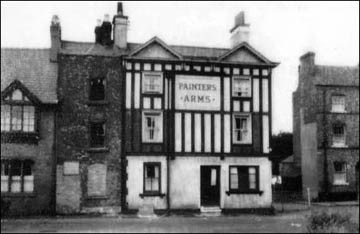 St. Martin's-in-the-Fields: The Painter's Arms, (no.1: illustrated left). Licencee in 1818-20 William Dobson (Pigot's Directory), in 1828 (when the street is referred to as St. Martin's Place) it was still William Dobson, 1n 1840 Mary Anne Reade, in 1855 Ellen Parry, in 1855 Ellen Parry, in 1857 Mrs M Davies, in 1871-80 Henry Walker, in 1902 Ignatius Ugalde (an unusual name! Where was he from?) in 1910-1914 John Maiden, in 1919-20 Mrs L Maiden, in 1934-42, Mrs E A S Bartlett. Bill & Kitty McAdoo had the place in the late 40s / early 50s. St. Martin's-in-the-Fields: The Painter's Arms, (no.1: illustrated left). Licencee in 1818-20 William Dobson (Pigot's Directory), in 1828 (when the street is referred to as St. Martin's Place) it was still William Dobson, 1n 1840 Mary Anne Reade, in 1855 Ellen Parry, in 1855 Ellen Parry, in 1857 Mrs M Davies, in 1871-80 Henry Walker, in 1902 Ignatius Ugalde (an unusual name! Where was he from?) in 1910-1914 John Maiden, in 1919-20 Mrs L Maiden, in 1934-42, Mrs E A S Bartlett. Bill & Kitty McAdoo had the place in the late 40s / early 50s.
Along with much else, it was demolished in the 1960s to make way for the Inner Ring Road. More information on / photographs of this pub would be gratefully received. A larger version of this photograph may be seen in our gallery.
St. Martin's Ash: The Ship Tavern was recorded in Pigot's 1818-20 Directory, licencee John Taylor. He was still there in 1822. This entire neighbourhood- in the vicinity of the Castle end of Nicolas Street and including the ancient Church of St. Martin- was bulldozed in the 1960s to make way for the Inner Ring Road.
St. Peter's Churchyard: The Three Crowns Inn formerly stood where Thomas Harrison's City Club and Commercial News Rooms stands at the south end of Northgate Street today. An inn had existed here as far back as 1272 when Richard de Knaresburgh left his daughter a shop "near the inn which was Hugh Selimon's towards the church of St. Peter's". Nothing more is heard of it for 500 years until, in 1782, The Three Crowns' landlord was Thomas Lewis. In 1855, historian, author and guide Thomas Hughes described the inn as having an old and picturesque gable front and that its chief entrance was from Shoemaker's Row with another from St. Peter's Churchyard. He also remarked that it had enjoyed its finest days long before it was eventually demolished in 1808, when its sign and licence were transferred to new premises in Pepper Alley- whose name was changed to The Bridgewater Tavern in 1831.
The Commercial Hotel has long traded in this quiet backwater, tucked away behind St. Peter's
Church in the heart of the city. The popular old pub was built as part of the same development as the Commercial Newsrooms on Northgate Street, by the prolific Chester architect Thomas Harrison. He was also responsible for the Northgate, the Grosvenor Bridge, the re-building of Chester Castle and much else in the city- but this was his only pub. It was abruptly closed down
in 2005 and an application was made to tear out its interior in
preparation for its conversion into what many suspected would be some
variety of wine bar. Planning permission was refused, the applicant,
Punch Taverns, did a runner and the place long sat derelict (having in the meantime been further damaged by a 'mysterious' fire).
But then, just before Christmas 2009, the old Commercial, restored and enlarged by incorporating the neighbouring offices, opened its doors once more and has resumed its ancient role as a popular watering-hole and meeting place in the heart of the city.
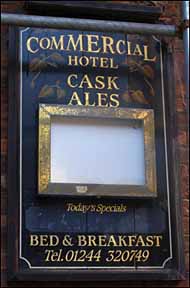 The Cheshire Sheaf recorded that the Commercial "was then (around 1817) kept by a Mr and Mrs Lee, afterwards by Mr and Mrs Sandford. Thomas Lee was still there in 1822. Afterwards came numerous unsuccessful tenants; until Mr Charles Davies, of an old Cestrian family, conducted the same during many years with great credit to himself and satisfaction to his supporters. The house still remains in his efficient hands". The Cheshire Sheaf recorded that the Commercial "was then (around 1817) kept by a Mr and Mrs Lee, afterwards by Mr and Mrs Sandford. Thomas Lee was still there in 1822. Afterwards came numerous unsuccessful tenants; until Mr Charles Davies, of an old Cestrian family, conducted the same during many years with great credit to himself and satisfaction to his supporters. The house still remains in his efficient hands".
In 1828 the licencee was Charles Sandford, in 1840 John Batho, in 1855 John Sheppard, in 1857 Mrs M Shepherd, in 1871 Charles E Davies, in 1880 Mr J Shepherd, in 1880 Charles E Davies (again?), in 1902 Mr S S Cullen, in 1910 Robert Powell, in 1914 William Wood, in 1934 M J Foster, in 1942 Charles Weymouth. The last landlord before Punch saw it off was Peter Tomkinson.
An inn by the name of The Rising Sun existed in St. Peter's Churchyard in 1782, when the landlady was Mrs. Gorton, on the site of the Commercial. Even earlier, around 1630, the clergy at St. Peter's lodged numerous complaints that the clientelle of this and the other inns surrounding the old churchyard (for it actually was a place of burial until the opening of the Overleigh Cemetery) used it as a short cut and "committed numerous nuisances" there- much as their descendents occasionally continue to do today in the narrow passagways leading to it. In 1808, it was referred to as The Sun Tavern and was earlier listed as such in Cowdroy's Directory in 1782. It is not to be confused with another Sun Tavern at 9 Northgate Street, which was recorded in 1675 and whose name was changed to The Sun Vaults by 1873. In 1808, the developers of the Commercial News Rooms acquired the inn in the churchyard and completely rebuilt it as we know it today, naming it The Commercial Tavern, the architect being, as previously mentioned, the great Thomas Harrison.
St. Werburgh Street: The Mitre Inn appeared in Pigot's Directory for 1828 when the licencee was Jas. Osborn. Another Mitre Inn traded in Pepper Street at this time.
The Crown Tavern was trading in 'Werburgh Street' in 1822-3, licencee William Culm.
St. Werburgh Street was, until the 1890s, half the width it is today. It is possible that both of the above inns were situated on the east side that was demolished to make way for John Douglas' splendidly ornate buildings that arose there in 1895-7.
Talbot Row (where was this?): The Hotel Inn (a curious name) traded here in 1795, the licencee being Thomas Jackson.
Theatre Passage: The Theatre Tavern traded here in 1840 according to the Chester Trades Directory. This is the narrow lane that connects St. Werburgh Street with Northgate Street, known today as Music Hall Passage. The theatre, music hall and- later, cinema- are long gone but the ancient building they once occupied remains with us today. Learn a little about it here..
The Bars: The Bars Hotel (no. 48 Foregate Street). Licencee in 1871 Edward Tasker, in 1910-20 Mrs C G Berry, in 1942 E W Pritchard. Part of it later became The King's Disco, Tiffany's and finally Cindarella Rockafella's,
with it's 'Monk's Retreat' and impressive facade. With taste and imagination this could easily
have been preserved but was instead demolished to make way for an inevitable apartment
development.
The Chester artist Jill Pears told us, " My sister and her friend remembers it as The King's Disco, then it changed its name to Tiffany's in 1976 or 7. There was a top floor where they played "super soul sounds". There was a large glitter ball in the centre and theatre-style spotlights. If I remember right, the walls were painted in a metallic pinky colour.
Downstairs, there was a huge tree trunk in the middle of the floor and African tribal masks on the walls that were lit inside. There was a mezzanine floor around the edge of the main dance floor where couples could sit at tables with cosy table lamps. Me and a few friends would go there on a Thursday or Saturday for the princely sum of 70 pence! If there ten or more, you got a bottle of bubbly ass well. If it was someone's birthday, they threw in a cake. I liked the downstairs better as they played general pop music such as the Bee Gees."
'JD' wrote to tell us, "One of the pubs I can vaguely
remember a few years ago was The Schooner Inn which was next door to Cinderella Rockerfellas. If I remember correctly it changed to The Sports Bar which was at its busiest on a Sunday night".
 Reader 'Hoolite' also recalled, "Oh, yes, I remember the Sports Bar alright. Lots of neon and chrome in the 'Amercian' tradition, a couple
of pool tables, long bar on the right hand side as you walked in.
Guaranteed major ruckus on most nights, being positioned right next
door to Cinders, which was the first club I ever went into being about 16- they weren't too choosy". Reader 'Hoolite' also recalled, "Oh, yes, I remember the Sports Bar alright. Lots of neon and chrome in the 'Amercian' tradition, a couple
of pool tables, long bar on the right hand side as you walked in.
Guaranteed major ruckus on most nights, being positioned right next
door to Cinders, which was the first club I ever went into being about 16- they weren't too choosy".
Keith Ellis told us "Before it was Cinderella Rockerfella's it was Tiffany’s- three floors of music, flashing lights and in the centre of the ground floor dance area, a large false tree with florescent leaves (20-25ft tall, the tree, not the leaves). The first floor was a balcony that overlooked the lower dance floor in what I think you would call today an atrium style and on the top floor was yet another disco and also a dining area. I met my wife there 30 years ago". You can see a larger version of this photograph of the Bars Hotel as it was in 1910 and of Cinder's just before it was demolished in our gallery.
John Murray wrote to tell us, "The Monk’s Retreat was a small bar to the rear of the Bars Hotel which was popular with both Navy and merchant sailors. My Great Grandma Elizabeth “Bessie” Ratchford was barmaid there from about 1918 until her husband Tommy’s death in 1960.
Bessie Hughes was born in Connah’s Quay in 1887, she moved to Liverpool around 1903 and worked in several shops and bars (rumour has it she lied about her age to get bar work) and it was in one of those pubs that she met her future husband, apprentice bookbinder Tommy Ratchford. The family moved to Chester in 1910 and lived at 22 Pitt Street, they had 8 children between 1905 and 1923, my Grandma Alice, being the eldest. Their daughter Elizabeth, also known as Bessie, born in 1910 married well known Chester butcher, Reg Lloyd.
A regular visitor to The Bars and Monk’s Retreat was Lord Sir Aubrey Brocklebank, the owner of Cunard Line, who lived at Nunsmere Hall (now a fine country hotel) near Delamere and a good friendship developed. Bessie’s son, James, born 1919 was fascinated with ships and got a job onboard Cunard’s ships sailing between Southampton and New York. He was a senior office on the Queen Elizabeth, which he showed me round in 1967 not long before her retirement from service. He then went on to work on the QE2 until his retirement in 1985. He died in 1991.
Bessie was described affectionately by many who knew her as a “larger than life character”. Some older Cestrian people still remember her well and speak of her. After Tommy’s death, she moved in with her daughter Bessie and Reg who lived on the corner of Hough Green and Cliveden Road until her death in 1966.
As a child, I remember visiting my Great Grandma, Elizabeth Ratchford (nee Hughes) while she was living with Great Uncle Reg (Lloyd) and Auntie Bessie (Elizabeth Ratchford) in their large house in Cliveden Road, Chester. Great Uncle Reg was a butcher in Chester with a market stall and a shop at 63 Bridge Street. He was a keen sportsman and in his time had been a boxer known as "The Butcher- Chester's White Hope" and he was groundsman at Boughton Hall Cricket Club. According to local history books, Reg was also a farmer at Brewer's Hall Farm in Curzon Park".
In April 2010, old Cestrian Gerald W Marsh, now in far-away Rochester, New York, USA, wrote us this fascinating letter: "I have just finished reading the account of the Monk's Retreat. I remember it very well. It was indeed a small bar, too small for more than one bartender, and that person was Bill Marsh" (Gerald is Bill's son). "He was the sole bartender from about 1929 until 1950 and got the job- an oft-told story- because the previous barman got sick and was unable to return to work.
Bill, who, like many in the depression era had been out of work for months, applied for the job, told them he was an expert bartender, cited several bars he had worked at in London, and got the job. In truth, he had never worked in a bar and barely knew a draft ale from a Sidecar cocktail. He "borrowed" a book on cocktails from the library, memorized as much as he could before he started work, then referenced the book throughout that first frantic evening. In the 1930s, he had sufficiently mastered his trade to enter a News of the World cocktail competition and won! I don't recall what the money prize was, but it was substantial. Alas, I don't know the name or recipe of his winning cocktail; it is buried in the microfiche files of the News of the World, and I am told I would have to visit London and search in order to locate it. The diploma hung on the back wall of the Monk's Retreat for years and when he left the owning Pritchard family refused to let him take it with him although the certificate was, obviously, awarded to him, not the Bars Hotel. When he died shortly thereafter my mother appealed to the Pritchards to let her have it, but to no avail.
Bill was the first insult comedian. To a balding man he would plump down his drink and say, "Rub some on your head, it might help." He would turn to a couple, ask the wife what she was having and then ask her,"What can I get for your father?" To a man with a colorful tie, "Where did you get the neckpiece?- Bertram Mills?" American soldiers, accustomed to the humor of ribbing, enjoyed him even more than the locals. He was enormously popular. Countless evenings I watched him work the crowd.
He worked seven days a week; Sunday the pub had reduced hours, and Monday was usually his evening off and he would take us- my mother, sister Jennie and me- to the Royalty Theatre. He worked hard. I remember that drays carrying barrels of beer would drive to the rear of the Bars; a steep slide would reach up to the Monk's Retreat at a 45 degree angle and Bill would haul the barrels up, one by one, pulling on a thick rope. All for £2.10.0 a week. On top of all this, during the war, he would do air raid duty, standing on the roof of the Bars at night, watching for German planes.
One night, and one only, Bill snaffled some sausages from the kitchen of the Bars, where black market food was always available for those who could afford it, and I remember to this day the taste! I was used to bright pink sausages, made mostly with bread, but these were laced with dark inviting bits of actual meat. Meat! What a treat it was.
Performers from the Royalty would head to the Monk's Retreat after the show, and Bill was on particularly friendly terms with comedians Frank Randell and Albert Modley. Sometimes he brought entertainers home and I recall a riotous evening with the Amazing Gridneffs, a Russian ladder acrobatic troupe- the youngest Gridneff son now teaches acrobatics in Blackpool and we have exchanged emails and he recalls visiting my house.
A previous writer referred to an Elizabeth "Bessie" Ratchford as working in the Monk's Retreat. In my many visits to the bar, I never met, or heard mentioned, Mrs. Ratchford. Perhaps there is a misunderstanding and she worked downstairs in the general bar. Certainly, to my knowledge, she did not work at the Monk's Retreat.
The Pritchard's son, Brian, if he is still around at about my age, 80, would be able to corroborate this. As, I am sure, would any older Cestrian. I still have Bill's cocktail recipe book. Wonder what the fine is by now?"
 Thomas Street: The Market Tavern stood on the corner of George Street, no 67. It is listed under George Street and has its own page, featuring a number of interesting photographs, in our gallery. It may be seen in this detail from the 1875 Chester OS map. Thomas Street: The Market Tavern stood on the corner of George Street, no 67. It is listed under George Street and has its own page, featuring a number of interesting photographs, in our gallery. It may be seen in this detail from the 1875 Chester OS map.
Tower Street: The Durham Ox was located at no. 37 Tower Street, at the junction of Pitt Street and Wellington Street in Newton. Its landlord in 1850 was William Stubbs, in 1857 H Pinnington, in 1880 Samuel Williams, in 1902 Charles Shirley White, in 1910-14 Walter Griffiths, in 1919-20 C S White (the same chap, or related to him, as in 1902?), in 1936 R David McAllister, in 1942 Charles Henry Boulter. Its site now lies beneath the St. Oswald's Way section of the Inner Ring Road. A larger photograph of the pub may be seen in our gallery.
The Liverpool Tavern. Listed in the History, Gazetteer & Directory of Cheshire, 1850 when the licencee was Joseph Carsley. This directory also mentions a Liverpool Arms trading in Brook Street. The Liverpool Arms ('The LA'), bearer of many previous names, continues to thrive in Northgate Street.
The Waterloo Tavern was trading in 'Towers Street' in 1840, licencee Elizabeth Peacock. Another Waterloo Inn was in Boughton.
"But if at church they would give some ale.
And a pleasant fire our souls to regale.
We’d sing and we’d pray all the live long day,
Nor ever once from the church to stray."
William Blake
Tower Wharf: The Ellsmere Canal Tavern, also known as The Canal Packet House. The building, now known as Raymond House, once housed both the offices
of the Ellsmere and Chester Canal Company and the Ellsmere Canal Tavern. It served passengers
waiting to use the Chester to Liverpool packet boats during the 18th
and early 19th centuries. The service was so successful that the
landlord, Captain Thomas Crimes, had to take on a second house, the
recently-closed Coach & Horses in Northgate Street (see above). In 1801, the licencee was Samuel Ackerlee, who paid
£1,000 per year for the privilege. Part of his advertisment ran, "He
has fitted up the tavern with good beds, wines, spirituously malt
liquors for the entertainment of families, travellers and the public in
general whose favours he humbly solicits assuring them it will be his
constant study to merit their approbation and support". Pigot's Directory for 1818-20 mentions the inn, calling it simply The Canal Tavern and its licencee as W Horabin. In 1828 the same directory lists John Hickson in charge. In 1822-3 Robert Griffith was the licencee.
By the 1850s, the railway had taken the trade away, the tavern closed
and the building became the head office of the Shropshire Union
Railways and Canal Company. Today it is the regional HQ of British
waterways. Immediately to the right of the old tavern stands what is
now a thriving bar, restaurant and live music venue, Telford's
Warehouse. Learn more about this fascinating part of Chester here...
 Trinity Sreet: The Wilbraham Arms. Listed in the History, Gazetteer & Directory of Cheshire, 1850, when the licencee was Mrs Ann Bateman. Slater's records her there in 1855, as she was in the Post Office Directory of Cheshire 1856 and the Chester Directory 1871. In 1880 the licencee was Joseph Newnham. It was situated close to Holy Trinity Church and may be seen in this detail of the 1875 Chester OS map. Trinity Sreet: The Wilbraham Arms. Listed in the History, Gazetteer & Directory of Cheshire, 1850, when the licencee was Mrs Ann Bateman. Slater's records her there in 1855, as she was in the Post Office Directory of Cheshire 1856 and the Chester Directory 1871. In 1880 the licencee was Joseph Newnham. It was situated close to Holy Trinity Church and may be seen in this detail of the 1875 Chester OS map.
Union Street: The King's Arms Tavern stood at 2 Union Street, opposite the end of Love Street. In 1840 its licencee was John Griffith, in 1850 James Dunn and in 1880 Edward Bennion. On 11th October 1884, the licence was transferred to Mrs Sarah Bennion from her late husband. Sarah was still there in 1914.
Reader Jane Hastings sent us the following sorry report in the Cheshire Observer, 21st May 1881 regarding Mr Bennion, her great great grandfather..
"Another Licencee Fined. Edward Bennion, of Union Street, was charged with being drunk in his own licenced premises. Inspector Farrell said he visited the King's Arms, Union Street, on Saturday night, the 7th inst., shortly after ten o'clock and found the defendant drunk in the kitchen. A man named Edward Thomas, who has since died, was also drunk in the same room. The defendant denied being drunk, but Detective Sergeant Murphy, who was with Inspector Farrell at the time, said he was drunk, and the magistrates being of the same opinion, fined him 10s and costs, or in default, seven days imprisonment with hard labour."
After closing as a pub, it became the Grosvenor Skating Rink (it would seem to have been extensively enlarged rearwards at this time) and then the Broadway Dancing Academy Ballroom, nicknamed 'The Ack'. It was a favourite haunt of American servicemen stationed around
Chester during WW2. (Their main camps were at Vicar's Cross- the site
of the present rugby club, the house and grounds of Hoole Bank House, now the Hammond School and at Burtonwood Air Base).
In the 1950s, it was renamed the Riverpark Ballroom.
The Beatles played one of their Chester dates here on 16th August 1962.
Their original, but freshly-sacked, drummer Pete Best was supposed to
play his final gig that night, but, not surprisingly, he didn't bother
turning up, and had to be hastily replaced with Johnny Hutchinson. (The
first Beatles concert with Ringo behind the drum-kit, at Hulme Hall in
Birkenhead, took place two nights later).
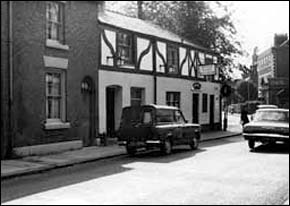 The Riverpark Ballroom closed the following year and today the site is occupied by NatWest's nondescript offices. Above is a painting of the Riverpark by local artist Jill Pears and a photograph of it is on the left. It now has its own page in our Lost Pubs Gallery, where you can see more photographs, incuding some fine ones of its interior. The Riverpark Ballroom closed the following year and today the site is occupied by NatWest's nondescript offices. Above is a painting of the Riverpark by local artist Jill Pears and a photograph of it is on the left. It now has its own page in our Lost Pubs Gallery, where you can see more photographs, incuding some fine ones of its interior.
Union Street used to be called Barker's Lane. There was a pub on Barker's Lane called The King's Arms, and this is the same name as the King's Arms on Union Steet, mentioned above, run by the Bennion family. In 1828 it changed it's name to The Union Arms before reverting back to The King's Arms in 1850. This Union Arms is mentioned in Pigot's Directory for 1828/9 when the licencee was Jas. Fitzgerald.
The Cheshire Observer, 4th October 1890, mentioned an inn curiously entitled The Bag's Arms trading in Union Street.
"Give my people plenty of beer, good beer and cheap beer, and you will have no revolution" Queen Victoria
Union Walk: The City Arms Tavern traded here in 1840, licencee John Roberts. Union Walk is the lane by the side of the Temple Bar off of Frodsham Street. The City Arms Tavern was later The City Arms and is now The Temple Bar on the corner of Union Walk and Frodsham Street.
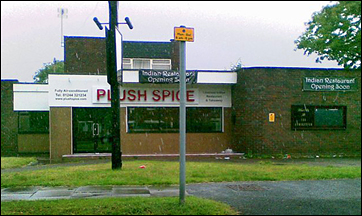 Upton (Liverpool Road): The Brewer's Arms: rebuilt and renamed The Frog. After a long period of closure, this pleasant little pub reopened in September 2014- but, by 2015, it had sadly closed again. The pattern continued but this pleasant pub now seems to be thriving under its new managers. Upton (Liverpool Road): The Brewer's Arms: rebuilt and renamed The Frog. After a long period of closure, this pleasant little pub reopened in September 2014- but, by 2015, it had sadly closed again. The pattern continued but this pleasant pub now seems to be thriving under its new managers.
Its licencee in 1919-20, was J Morris, in 1934 Mrs R F Archer, in 1942
Mrs Kathleen Archer.
The Gamekeeper (86 Newhall Rd near its junction with Weston Grove). After it closed it became an Indian Restaurant by the name of Plush Spice. As the CAMRA review put it, "modern estate pub with a bit of a reputation; smell of testosterone replaced by whiff of curry upon metamorphising into Plush Spice in Sept 2011".
That, in turn, closed a few years ago and the building is now scheduled for demolition, to be replaced a small block of 12 flats. More info about the Gamekeeper please!
 Vicars Cross: The Centurion in Oldfield Drive (illustrated right) was sold in early 2015 by Admiral Taverns, based at the Steam Mill in Chester, to a Leeds-based construction company, LNT Construction. They aimed to demolish the pub and build a 68 bed care home but, after a great deal of opposition, the application was rejected by council planners and rejected again when the developers appealed to the government. Public pressure resulted in the Centurion being made an Asset of Community Value and the pub has since re-opened. More on this to follow.. Vicars Cross: The Centurion in Oldfield Drive (illustrated right) was sold in early 2015 by Admiral Taverns, based at the Steam Mill in Chester, to a Leeds-based construction company, LNT Construction. They aimed to demolish the pub and build a 68 bed care home but, after a great deal of opposition, the application was rejected by council planners and rejected again when the developers appealed to the government. Public pressure resulted in the Centurion being made an Asset of Community Value and the pub has since re-opened. More on this to follow..
Victoria Road: The Northgate Arms (no 3 Victoria Road, which was curtailed by the Ring Road), was a large pub lying between the shabby mess that is today's Delamere Street and the St. Oswald's Way stretch of the Inner Ring Road, was seen to be closed and boarded up as recently as July 2007. It must have been a well-situated thriving pub once, before the coming of the ring road and the demise of Northgate Railway Station and the Cattle Market. Those days are long gone, alas, and it would frankly have been no surprise if its isolated and unattractive situation hadn't led to its closure sooner.
Rumour has it that the pub and its neighbouring buildings will be demolished as part of the great changes hereabouts, including the vast 'super surgery' complex on the adjoining former Delamere Street Bus Station site. Indeed, the old pub was utilised as the site office for this work and the construction of the new bus station on nearby Gorse Stacks..
Its landlord from 1919 to at least 1936 was W J Thelwell. A photograph of it in 2009 can be seen under Delamere Street.
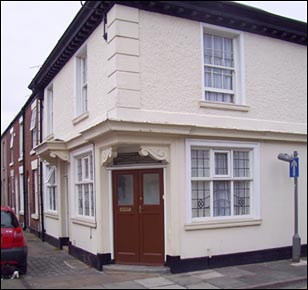 Walls Lane: Cowdroy's Directory of Cheshire, 1789 mentions an inn here called 'Loggerheads' (we assume it was an inn...) Walls Lane was an old name for today's Blackfriars. Even earlier, it was called Arderne Lane. It long formed the boundary between the monastic estates of the Blackfriars and the Nuns of St. Mary's. Walls Lane: Cowdroy's Directory of Cheshire, 1789 mentions an inn here called 'Loggerheads' (we assume it was an inn...) Walls Lane was an old name for today's Blackfriars. Even earlier, it was called Arderne Lane. It long formed the boundary between the monastic estates of the Blackfriars and the Nuns of St. Mary's.
Walter Street: The New Inn (no. 28), landlord in 1871 Frederick Swindley, 1880 George Tushingham, who was still there in 1920- a G Tushingham is listed in the 1919-20 trades directories- the same George, there for 40 years? In 1936-42, it was William P Tushingham- George's grandson? Les Campbell was landlord there in the late 1960s / early 1970s. He later moved to The City Arms now The Temple Bar in Frodsham Street. Ruth Chidlow was the tenant about 1990. Barry Hughes fitted in somewhere (when?) and then, as we’re informed, “a big bloke from Helsby, I think his name was Griff.”
The New Inn is now private housing, split into flats, but still looks every inch a pub. Illustrated left.
In May 2010, Lucy Tushingham wrote to us, "I’m looking for information and photos on the New Inn Pub that I think is no longer there. My great granddad ran the New Inn and my dad was born there. William Probyn Tushingham was his son, he took the name Probyn from his mother Annie. There was a gentleman called Chris Jeffery who wrote on the site in 2004 stating he used to live opposite the pub and had photos, would you be able to contact him for me?"
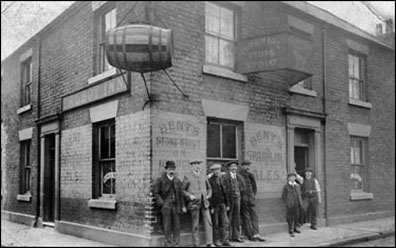 Back in 2004, Mr Jeffery had indeed written, "I also remember the New Inn, corner of Church Street & Walter Street in Newtown, I lived as a young child opposite, it is now flats. (Somewhere I have a picture of it, if I find I'll send it to you)". If you read this, Chris, write again (and send that picture!) or contact Lucy directly. The same applies to anyone else with memories of The New Inn and other vanished Newtown pubs. Above right is a picture of the place as it is now, taken by the author in July 2010. Back in 2004, Mr Jeffery had indeed written, "I also remember the New Inn, corner of Church Street & Walter Street in Newtown, I lived as a young child opposite, it is now flats. (Somewhere I have a picture of it, if I find I'll send it to you)". If you read this, Chris, write again (and send that picture!) or contact Lucy directly. The same applies to anyone else with memories of The New Inn and other vanished Newtown pubs. Above right is a picture of the place as it is now, taken by the author in July 2010.
The Talbot: corner of Walter Street and Church Street, opposite The New Inn. generally known as 'The Dog'. Our photograph, right, shows it and some of its regulars in 1930. Look at the size of that cask hanging above the street!
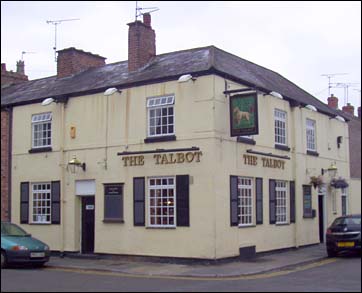 Actually, although closed for a period of time, we should point out that the Talbot is once again open and thriving as a characterful local under landlord Pat Wallace. (but, because of that fab picture, we didn't have the heart to remove it from these pages!) Contrast the old picture of the place with the one below, taken by the author on a rainy day in July 2010... Actually, although closed for a period of time, we should point out that the Talbot is once again open and thriving as a characterful local under landlord Pat Wallace. (but, because of that fab picture, we didn't have the heart to remove it from these pages!) Contrast the old picture of the place with the one below, taken by the author on a rainy day in July 2010...
Watergate Street: The Fox and Goose- a note in the Cheshire Sheaf in 1915 tells us "that it was situated on the north side of Wategate
Street adjoining St. Peter's Church, and is doubtless the house now
known as The Victoria" (which is still with us today). Before 1670, the licencee was Elizabeth Leighfield and at this date it
passed to a cooper named Hugh Roberts. It was passed on through this
family until 1765 when it was acquired by the Stringer Family, who
remained in occupation "for the best part of another hundred years".
The Linen Hall Tavern: (No 76). This inn was listed in Cowdroy's Directory in 1789, when the licencee was Jarvis Walker. In 1857 the licencee, according to the Post Office Directory of Cheshire was another J Walker. In 1910 the licencee was Mrs Margaret Jane Watson, in 1914 Mr C Jenkins.
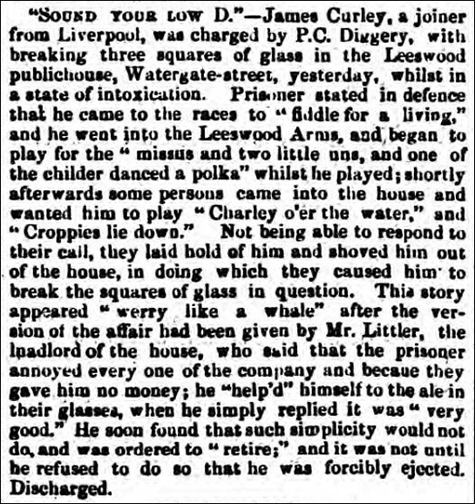 Slater's Directory 1855 lists an inn by the curious name of Uncle Tom's Cabin trading in Watergate Street, licencee George Mathers. The inn later changed its name to The Leeswood Arms and appears as such in the Post Office Directory of Cheshire in 1857, the licencee being F Littler (who is mentioned on the right). Joseph Hill had the place in 1871. The Chester Chronicle, 27th January 1866, reported that the licencee of "the Leeswood Arms, (otherwise Uncle Tom's Cabin) beerhouse" had been charged under the Public House Closing Act. Slater's Directory 1855 lists an inn by the curious name of Uncle Tom's Cabin trading in Watergate Street, licencee George Mathers. The inn later changed its name to The Leeswood Arms and appears as such in the Post Office Directory of Cheshire in 1857, the licencee being F Littler (who is mentioned on the right). Joseph Hill had the place in 1871. The Chester Chronicle, 27th January 1866, reported that the licencee of "the Leeswood Arms, (otherwise Uncle Tom's Cabin) beerhouse" had been charged under the Public House Closing Act.
This cutting from The Cheshire Observer tells of another incident at the Leeswood Arms in May 1857..
The Swan- existed in 1766 (Cheshire Sheaf).
The Sun Tavern (Watergate Street Row). Listed in Pigot's Directory 1818, licencee James Parry (still there in 1823), and 1828/9 when the licencee was William Ward, in 1840 Joseph Pownall (also listed as a wire worker). Also in the History, Gazetteer & Directory of Cheshire, 1850 when its licencee was John Jones. The Post Office Directory of Cheshire in 1857 listed The Sun trading in Watergate Street Row, licencee, as above, John Jones. In 1871 William Roberts was the proprietor. Another Sun Tavern long traded at 9 Northgate Street and The Sun Vaults once stood on the site of today's Commercial Hotel in St. Peter's Churchyard.
The Old Pointer Dog (next to Pointer Dog Entry, Watergate Row). Listed in Pigot's 1828-1829 Directory when the landlord was John Johnson. It appeared in the 1840 Chester Trades Directory, licencee Samuel Gregg. The inn was recorded in Slater's Directory 1855 but no licencee was named. No mention of the inn appears in the 1871 directory as, by this time, it had chaged its name to The Chainmaker's Arms.
The Castle & Falcon- situated in Watergate Row North, between St. Peter's Church and Goss Street and first mentioned as existing in 1729. In 1730, as mentioned in Robert Freke Gould's The Four Old Lodges (1879), it was listed, under the name Castle and Faulkon, as being a masonic lodge meeting place.
In 1760 the landlord, Lawrence Smith moved from here to The Yacht Inn further down the road (see below). Licencee 1782-95 Francis Lake, 1809 Mrs Bevan, in 1818-23 W B Cooke, in 1828 Ann Cooke, in 1846-60 Mrs Mary Jones, in 1871 G Haynes Denton. In 1874 a licence was refused to Joseph Salmon on the grounds that the building was no longer being used as a public house. However, in the same year, it was recorded that a spirit vaults was being kept by a Miss Emma Salmon at 16 Watergate Street- that is, on the street level directly below the old Castle & Falcon.
In the 1904 the licencee of Salmon's Vaults was Thomas Clarke and in 1912, T Meacock. The inn was last recorded during the 1930s when it was closed and replaced by Breward's China Stores. Just before WW2, the premises became part of Aston's showrooms. The Castle & Falcon was included in a list of polling stations in 1809.
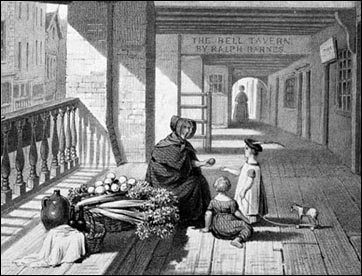 The Bell Tavern-
existing in 1840 in Watergate Row North when the licencee was Ralph Barnes, whose name may be seen on the inn sign in this old view of the Row. The Chester Trades Directory for that year has him as "Printer and Bell Tavern" as the inn's location as 'Watergate Back Row'. The Bell Tavern-
existing in 1840 in Watergate Row North when the licencee was Ralph Barnes, whose name may be seen on the inn sign in this old view of the Row. The Chester Trades Directory for that year has him as "Printer and Bell Tavern" as the inn's location as 'Watergate Back Row'.
The Drover's Arms was also located in Watergate Back Row in 1840 when its licencee was William I Jones- who was also a hosier. Slater's Directory for 1855 lists William Davies as proprietor.The inn is absent from the 1871 directory.
The Three Pigeons - also recorded in the polling station list in 1809.
The Sign of the Golden Anchor- mentioned in a 1750 edition of the Chester Courant. Resident there, we read, was one Robert Bellin, who "doth undertake to cure scald heads, he having been instructed by his late father, deceased. N.B. No cure no pay". The Chester Trades Directory in 1850 lists The Anchor in Watergate Street. Its landlord was Charles Jones and earlier, in 1781, William Flockart.
The Star Inn- Mentioned in a 1750 Chester Courant, run by a Mrs Griffiths, who was still there in 1768. Listed in Cowdroy's Directory in 1789, when the licencee was Edward Walmsley. It was recorded as being used as a polling station in 1809.
Ye Hand & Snake- recorded in 1723; writing the Cheshire Sheaf in July 1915, Mr John Hewitt of Hoole declared- for unstated reasons-
that "the Hand and Snake must surely be the premises now known as Leche House in Watergate Street".
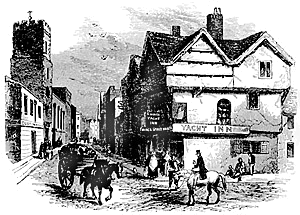 The Yacht Inn (no 81, illustrated left and below) was, along with every other building on the left hand side of the picture, demolished in the 1970s to make way for the widening of Nicloas Street as part of the Inner
Ring Road. The Yacht Inn (no 81, illustrated left and below) was, along with every other building on the left hand side of the picture, demolished in the 1970s to make way for the widening of Nicloas Street as part of the Inner
Ring Road.
Its landlord in 1749 was Thomas Hart, in 1780-81 Simeon Leet, in 1782 Mrs Leet, in 1818-28 Benjamin Powell, in 1840 James Osborne, in 1850 John Heppel, in 1855 George White, in 1871 Mrs Evans, in 1880 Daniel Miller, in 1902 Henry Ellison Ostle, in 1910-1920 William Henry Lucas, in 1935/6 Mrs Ada Barlow. Recorded as being used as a polling station in 1809.
Confusingly, the splendid 17th century building in Watergate Street
known as Bishop Lloyd's House was also, in the latter part of the 18th century, licenced as The Yacht Inn. After a lapse of many years, it was re-licenced in the 1880s as The Palace Vaults in the charge of Mr and Mrs Woolley. The bar was at row level with a smoke room above. In the loft were chickens kept as pets by the Woollie children.
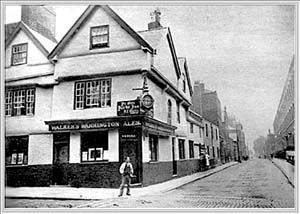 This advertisement for the old Yacht appeared in Adams’s Weekly Courant, 7th March 1780: This advertisement for the old Yacht appeared in Adams’s Weekly Courant, 7th March 1780:
"YATCH INN, Chester. SIMEON LEET, OF the PY’D BULL, in Northgate-street, Chester, humbly begs Leave to inform the Public, That for several Reasons, particularly the great Distance of his present House from the Center of the City, which rendered it very inconvenient to Travellers, he has taken that compleat and old-established Inn, the YATCH, and intends entering on it by the 25th of this Inst. March, where he hopes to be honoured with the Countenance of his Friends who have resorted to the Py’d Bull, as well as those Gentlemen who have usually bestowed their Favours to the Yatch.
The Yatch will be fitted up in a very commodious Manner, and the utmost Endeavours will be exerted to give the fullest Satisfaction to all his guests, and to prove himself their very gratefully obliged and obedient humble Servant, SIMEON LEET.
N. B. Good Post-Chaises and careful Drivers at the shortest Notice".
Simeon was soon to pass on, apparently, as The Yacht appears in Cowdroy's Directory two years later, in 1782 with its licencee being given as Mrs Leet. You can read more about the venerable Yacht Inn and see more pictures of it on its own page in our Lost Pubs of Chester Gallery...
"St. George he was for England,
And before he killed the dragon
He drank a pint of English ale
Out of an English flagon".
G K Chesterton
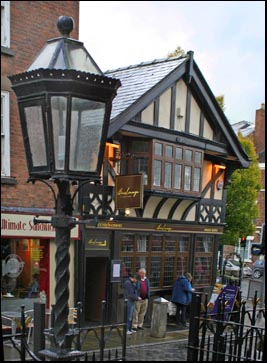 Next to the vanished Yacht was the 200 year-old Axe Tavern, (illustrated left: no 75 Watergate Street, on the corner of Nicolas Street). This inn changed it's name often: The Old Axe Tavern in 1828 (Richard Brayne, prop), The Axe Tavern in 1840 when Mrs Andrews was in charge, and simply The Axe in 1850. It was again listed as The Axe Tavern in 1855 when Michael Foster was the licencee, and also when Edward Greenwood was in charge in 1871. It was The Axe in 1880 when Edward Greenwood was the gaffer and The Axe Tavern yet again in 1914. Next to the vanished Yacht was the 200 year-old Axe Tavern, (illustrated left: no 75 Watergate Street, on the corner of Nicolas Street). This inn changed it's name often: The Old Axe Tavern in 1828 (Richard Brayne, prop), The Axe Tavern in 1840 when Mrs Andrews was in charge, and simply The Axe in 1850. It was again listed as The Axe Tavern in 1855 when Michael Foster was the licencee, and also when Edward Greenwood was in charge in 1871. It was The Axe in 1880 when Edward Greenwood was the gaffer and The Axe Tavern yet again in 1914.
Its landlord in 1818-22 was William Maylor, in 1828 Richard Brayne, in 1850 Michael Foster, in 1902 John Vernon. In 1910-20 Mrs Sophia Vernon was in charge, in 1934 to at least 1936 Alfred Foulkes, in 1942 Harry Carter.
In the 1990s, as part of the Firkin brewing chain, it was for a while known The Falchion & Firkin but is now re-named Bar Lounge. It appeared on a list of polling stations in 1809. Compare this modern picture with a nice old photograph of The Axe in our gallery when it stood next door to the ancient, but long-vanished Yacht Inn.
The Crown Inn (mentioned in the Cheshire Sheaf as existing in 1730).
The Rob Roy. Details needed..
The Moon Tavern, The Albion Tavern, Ye Deva Hotel. A licenced premises since the mid 17th century which long retained a fine Elizabethan interior with most of its beams, stairs and fireplaces, still intact. As to how that fine interor has been treated of recent times, see below...
It was one of a number of properties in Chester to be subject to the Execution Rent. Execution Rent Tenants were bound to keep watch on the City Walls on three nights in the year, namely on Christmas Eve, Christmas Day, and St. Stephen's Day (26th December) and they were bound to mount guard over and conduct felons and robbers as far as the gallows at Boughton. For their services these tenants were "exempt from attendance on all inquisitions, juries and assizes, except when held before the Lord, the Prince and the Earl of Chester". It was recorded as being used as a polling station in 1809.
It was listed as The Moon Tavern in Pigot's Directory 1818-20 when the licence was held by Chas Pover. It was renamed The Albion Tavern (licencee in 1855 C Wooley and 1871 Thomas Sparks) and later Ye Deva Hotel (a later still variation being The Olde Deva Hotel) and was recalled in the Sheaf as having entertained the choirboys of the Cathedral at Christmas in the middle of the 19th century. It was run at the time by a Mrs Matthews, "a
thoughtful, respectable woman, a fine specimen of the real
old-fashioned sort of landlady, of whom I suspect there are not many
now to be met with under the shadow of 'mine inn'".
The Deva was originally a two storey pub, however the street level pub closed down, leaving the Row level section of the pub only, at 8 Watergate Row North. It finally closed and became a wine and dine bar called The Room, but has since changed to a wine bar/restaurant called Amber Lounge.
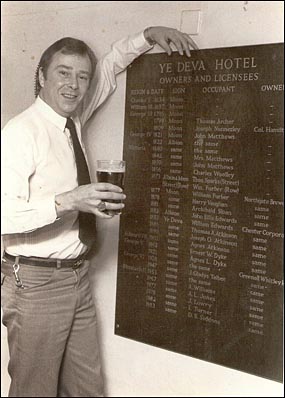 In 2012, the excellent Chester Beer Project voted Amber Lounge the third worst pub in Chester. This is what they said, "This place is completely devoid of character, which is quite an astonishing thing to say about a building that dates from at least the 16th century. Nevertheless, it’s true. So while the ambience or whatever isn’t exactly offensive in any way, the really depressing thing is the wasted potential and the contempt with which the building’s provenance has been treated. An interior design ponce has obviously been let loose in here some time in the mid 90s and armed with a ‘minimalist sensibility’ and a few cans of white paint has vandalised the magnificent Elizabethan structures and fittings. Hopefully, someone with half a brain will restore it all at some point – and will get some decent ale in an’ all". In 2012, the excellent Chester Beer Project voted Amber Lounge the third worst pub in Chester. This is what they said, "This place is completely devoid of character, which is quite an astonishing thing to say about a building that dates from at least the 16th century. Nevertheless, it’s true. So while the ambience or whatever isn’t exactly offensive in any way, the really depressing thing is the wasted potential and the contempt with which the building’s provenance has been treated. An interior design ponce has obviously been let loose in here some time in the mid 90s and armed with a ‘minimalist sensibility’ and a few cans of white paint has vandalised the magnificent Elizabethan structures and fittings. Hopefully, someone with half a brain will restore it all at some point – and will get some decent ale in an’ all".
In June 2010, we were pleased to hear from reader Dave Siddons who wrote, "Hi, first of all can I say what a great web site you are running. I have forewarded it to all my friends all over the world.
In 1983 I became landlord of The Olde Deva in Watergate Street (now known as The Amber Lounge). It was a split-level pub with a bar on the street and a bar on the Rows. I decided to research the history and had this board made which shows all the publicans from King Charles's day up to 1983. We left The Deva in 1986 and took over the Rake and Pikel. In 1988 I became Landlord of The Oddfellows Arms untill we retired in 2006. I hope this picture will help with your pubs past and present site".
Indeed it does, Dave, and many thanks for sending it. A larger version of the photograph is in our Lost Pubs Gallery. The excellent information it contains is as follows (with some additional notes of our own)-
The Moon. Mentioned in 1634, 1697 and 1795. The first licencee listed is Thomas Archer in 1799. In 1809 the inn is listed as belonging to one Colonel Hamilton and the landlord was Joseph Nunnerly. In 1821 it was John Matthews (although another directory says William Matthews was in charge in 1822-3). In 1822, the name changed to The Albion Tavern. It was listed as such in Pigot's 1828/9 Directory. John Matthews was still in charge and remained so for another twenty years, until 1842 when his widow Mrs Matthews took control. In 1850 another John Matthews (their son?) was the licencee. The Albion appeared in the Chester Trades Directory in this year. In 1856 Charles Wooley was landlord. He appears as such the 1859 Post Office Directory of Cheshire.
In 1873, the inn's name became an amalgam of past and present: The Albion & Moon and the street and Row levels were separated, the landlord of the lower being Thomas Sparks and that of the higher, Row premises William Furber.
In 1877 the inn was acquired by the Northgate Brewery (until 1883) and William Furber is recorded as the licencee (of the reunited premises, presumably). In 1878, Harry Vaughan was in charge, in 1881 Archibald Sloane, in 1882 John Ellis Edwards. The name changed to that of The Albion in this year but, just a year later, it was changed again to Ye Deva and its owner is given as Chester Corporation. Licencee in 1886 Thomas A Atkinson, in 1890 Joseph O tkinson, in 1903 Agnes Atkinson, in 1912-20 Ernest W Dyke, in 1921 to at least 36 Mrs Agnes Lloyd Dyke.
In 1938, the Deva was
bought by the brewers Greenall Whitley, Agnes Dyke still being the tenant until 1947 when J Gladwys Talbot took over. In 1967 it was A Wiliams, in 1977 A L Jones, in 1978 J Lowry, in 1882 I Turner and in 1983 our kind informant Mr D B Siddons moved in, staying until 1988.
The Old Wolf's Head- mentioned in a 1749 edition of the Chester Courant. In 1752, John Lamkin advertised that he had moved from the Old Wolf's Head to the Sign of the Golden Lyon in Foregate Street.
The Red Dog. This inn was listed in Cowdroy's Directory in 1789 when the licencee was Mrs Bateman.
The Wheat Sheaf Tavern is listed in Pigot's Directory 1818-20 when the licencee was Samuel Upton (also 1822) and in 1828, licencee David Hughes.
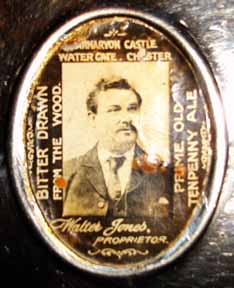 The Carnarvon Castle (no. 42, corner of Crooke Street, but the 1859 Post Office Directory of Cheshire says no.155). It was recorded as being used as a polling station in 1809. The Carnarvon Castle (no. 42, corner of Crooke Street, but the 1859 Post Office Directory of Cheshire says no.155). It was recorded as being used as a polling station in 1809.
Reader Nathan Brett wrote to tell us, "Hallo!
I was looking through your website of old forgotten pubs in Chester
hoping to discover something of the Carnarvon Castle on Watergate Street. I
thought that the attached photo may be of interest. It is from a silver
plated cigarette holder that belonged to my grandfather Terry Jones who
was one of twin sons to the chap in the photo, the proprietor of The
Carnarvon Castle, Walter Jones (my great grandfather).
Terry's twin was
called Leo and there was also an older son called Walter after his
father who was a Private in the Cheshire regiment and died in WW1 in
Belgium, I believe his name is recorded on a wooden plaque along with
the other fallen soldiers of Chester in City Hall (?)
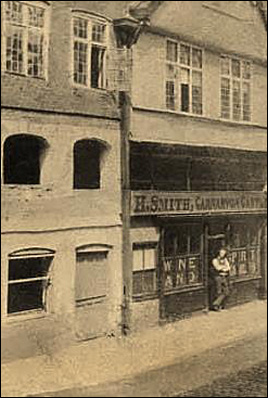 I think the
"Prime Old Tenpenny Ale" sounds pretty good... I know very little else
other than the twins did not get on that well and my grandfather lit a
fire in the Carnarvon Castle under his brother Leo's bed! Happily all
concerned were ok and the pub was saved from an even earlier demise! I think the
"Prime Old Tenpenny Ale" sounds pretty good... I know very little else
other than the twins did not get on that well and my grandfather lit a
fire in the Carnarvon Castle under his brother Leo's bed! Happily all
concerned were ok and the pub was saved from an even earlier demise!
I've never been to Chester and live near Bath now and if you know
anything more of this pub or its inhabitants or if you have a photo
past or present of the building, I would be most grateful!"
This inn was listed in Cowdroy's Directory in 1789 when the licencee was Charles Brown. In 1818 the licencee was J Moore, in 1822-3 Robert Montgomery, in 1828 James Davies, in 1840 Michael Foster, in 1850 Matt Williams, in 1855 Emanuel Harton, in 1859 H Smith (seen left in the doorway of his inn in 1870), in 1871 Mrs Jones, in 1880 John L Walker, in 1898 Patrick Churchill (see below), in 1902 Walter J Jones (see above), who was still there in 1920 (he appears in a 1919-20 trade directory). Today a bookmaker's occupies the site of the old inn.
Reader Ken Dennis recently wrote, "I caught the end of your interview on Radio Merseyside (on the subject of 'the lost pubs of Chester') and noted your web address. A rich seam of varied information and for me a source of some information I was after. My Great grandfather was supposed to have had a pub in Chester, that being the "Carnarvon Castle" in Watergate Street. I can remember visiting the Rows many years ago with other members of my family and we had discovered the name on one of the upper beams, it was painted over put still discernible. My problem being that I do not have any corroborating proof of him being there and for which years. I have a daughter's birth certificate on which he states that he was the licensee in 1898 and a large portrait photo of himself, on the back of which is written "Carnarvon Castle". His name was Patrick Churchill and he was a baker by trade. He later moved over to Liverpool to run a public house there. On your list of proprietors for this establishment he is not listed." He is now Ken!
The Carnarvon Castle now has its own page, including some pictures of how the place looks today, in our Lost Pubs Gallery..
The Corkcutter's Arms was in Watergate Street Row. The licencee in 1822-3 was John Edwards.
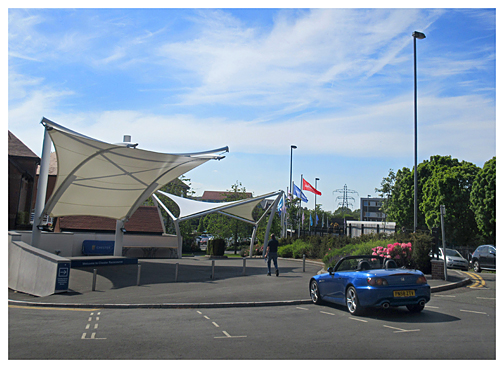 Watergate Square: The Watergate Inn (8-10 Watergate Square) was demolished in February 2018. Originally The Turf Tavern, it was later renamed The Watergate Inn. Its licencee in 1856 was John Poole, in 1871 Thomas Kitchin, in 1880 William Jones, in 1914 Joseph H Burrows, in 1935 G Downs DCM. Its final licencee was Frank Marnall who retired, after twenty five years, in 2018. Watergate Square: The Watergate Inn (8-10 Watergate Square) was demolished in February 2018. Originally The Turf Tavern, it was later renamed The Watergate Inn. Its licencee in 1856 was John Poole, in 1871 Thomas Kitchin, in 1880 William Jones, in 1914 Joseph H Burrows, in 1935 G Downs DCM. Its final licencee was Frank Marnall who retired, after twenty five years, in 2018.
The Chester Race Company bought the inn from pubco Enterprise Inns the previous year, with Mr Marnell staying on for a while until his retirement. Rumours of its fate soon abounded, which the Race Company’s head of marketing Stephanie Hughes attempted to scotch: “There are no immediate plans for it currently. We’ve invested in the aesthetics of the place to make it more presentable for race days and it is open for the season on race days".
Soon afterwards, plans were announced to radically re-model the entrance to the racecourse, strengthening rumours of the pub's impending demolition, which soon proved to be true. Here we see the inn's site in Spring 2019, marked today merely by a couple of pointless tent-like structures..
The Watergate Tavern, presumably another name for the above, was recorded as being used as a polling station in 1809. The Watergate Tavern was listed in the 1828-1829 directory as being in Paradise Row (when the licencee was Robert Evans), one of the three new streets laid out followed the canalization of the lower river in the first half of the eighteenth century. It no longer exists. The Chester Trades Directory in 1840 puts the inn in Watergate Place and its proprietors as Mary Ann and E Evans.
A writer in the Cheshire Sheaf in 1945 noted, "about sixty years ago, there were two public houses in Watergate Square- The Turf Tavern (now The Watergate Inn at the end of Paradise Row) and The Clock Vaults at the angle formed by Middle and New Crane Streets". Referring to the Old Port in general, he remarked, "In view of the liberal distribution of public houses that formerly existed in Chester it is rather surprising that in this area, so closely associated with sailors, there were only two in 1782, namely The Ship (now The Flint Boat House) at the Crane, and The Waggoner at the Water Gate. At a later date others existed, but they were of little importance and interest. The many thrilling stories of adventure that must have been narrated within their walls cannot now be recalled"..
The Jolly Sailor is listed in Cowdroy's Directory in 1782, its licencee being Mrs Matthews and its location "Watergate". She was still there in 1789.
Weaver Street: The Custom House Tavern was trading in Weaver Street in 1840, licencee Charles Powell. This is undoubtedly the still-thriving 17th century Customs House Inn on the corner of Weaver and Watergate Streets. In 1822, when it was classed as being in Watergate Street, M Owens had it. |
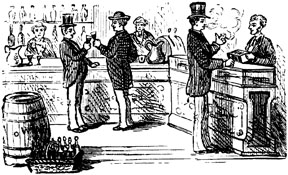

 St. Martin's-in-the-Fields:
St. Martin's-in-the-Fields: Reader 'Hoolite' also recalled, "Oh, yes, I remember the Sports Bar alright. Lots of neon and chrome in the 'Amercian' tradition, a couple
of pool tables, long bar on the right hand side as you walked in.
Guaranteed major ruckus on most nights, being positioned right next
door to Cinders, which was the first club I ever went into being about 16- they weren't too choosy".
Reader 'Hoolite' also recalled, "Oh, yes, I remember the Sports Bar alright. Lots of neon and chrome in the 'Amercian' tradition, a couple
of pool tables, long bar on the right hand side as you walked in.
Guaranteed major ruckus on most nights, being positioned right next
door to Cinders, which was the first club I ever went into being about 16- they weren't too choosy". 







 Slater's Directory 1855 lists an inn by the curious name of Uncle Tom's Cabin trading in Watergate Street, licencee George Mathers. The inn later changed its name to The Leeswood Arms and appears as such in the Post Office Directory of Cheshire in 1857, the licencee being F Littler (who is mentioned on the right). Joseph Hill had the place in 1871. The Chester Chronicle, 27th January 1866, reported that the licencee of "the Leeswood Arms, (otherwise Uncle Tom's Cabin) beerhouse" had been charged under the Public House Closing Act.
Slater's Directory 1855 lists an inn by the curious name of Uncle Tom's Cabin trading in Watergate Street, licencee George Mathers. The inn later changed its name to The Leeswood Arms and appears as such in the Post Office Directory of Cheshire in 1857, the licencee being F Littler (who is mentioned on the right). Joseph Hill had the place in 1871. The Chester Chronicle, 27th January 1866, reported that the licencee of "the Leeswood Arms, (otherwise Uncle Tom's Cabin) beerhouse" had been charged under the Public House Closing Act. The Bell Tavern-
existing in 1840 in Watergate Row North when the licencee was Ralph Barnes, whose name may be seen on the inn sign in this old view of the Row. The Chester Trades Directory for that year has him as "Printer and Bell Tavern" as the inn's location as 'Watergate Back Row'.
The Bell Tavern-
existing in 1840 in Watergate Row North when the licencee was Ralph Barnes, whose name may be seen on the inn sign in this old view of the Row. The Chester Trades Directory for that year has him as "Printer and Bell Tavern" as the inn's location as 'Watergate Back Row'.  The Yacht Inn
The Yacht Inn
 In 2012, the excellent
In 2012, the excellent  The Carnarvon Castle (no. 42, corner of Crooke Street, but the 1859 Post Office Directory of Cheshire says no.155). It was recorded as being used as a polling station in 1809.
The Carnarvon Castle (no. 42, corner of Crooke Street, but the 1859 Post Office Directory of Cheshire says no.155). It was recorded as being used as a polling station in 1809.  I think the
"Prime Old Tenpenny Ale" sounds pretty good... I know very little else
other than the twins did not get on that well and my grandfather lit a
fire in the Carnarvon Castle under his brother Leo's bed! Happily all
concerned were ok and the pub was saved from an even earlier demise!
I think the
"Prime Old Tenpenny Ale" sounds pretty good... I know very little else
other than the twins did not get on that well and my grandfather lit a
fire in the Carnarvon Castle under his brother Leo's bed! Happily all
concerned were ok and the pub was saved from an even earlier demise!  Watergate Square:
Watergate Square: